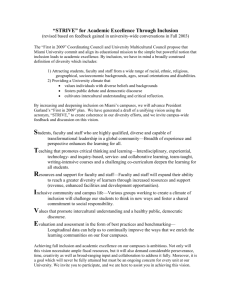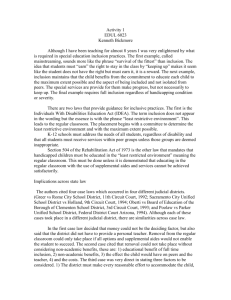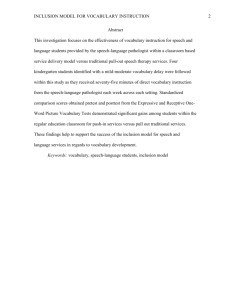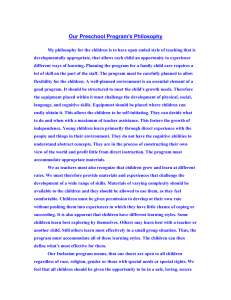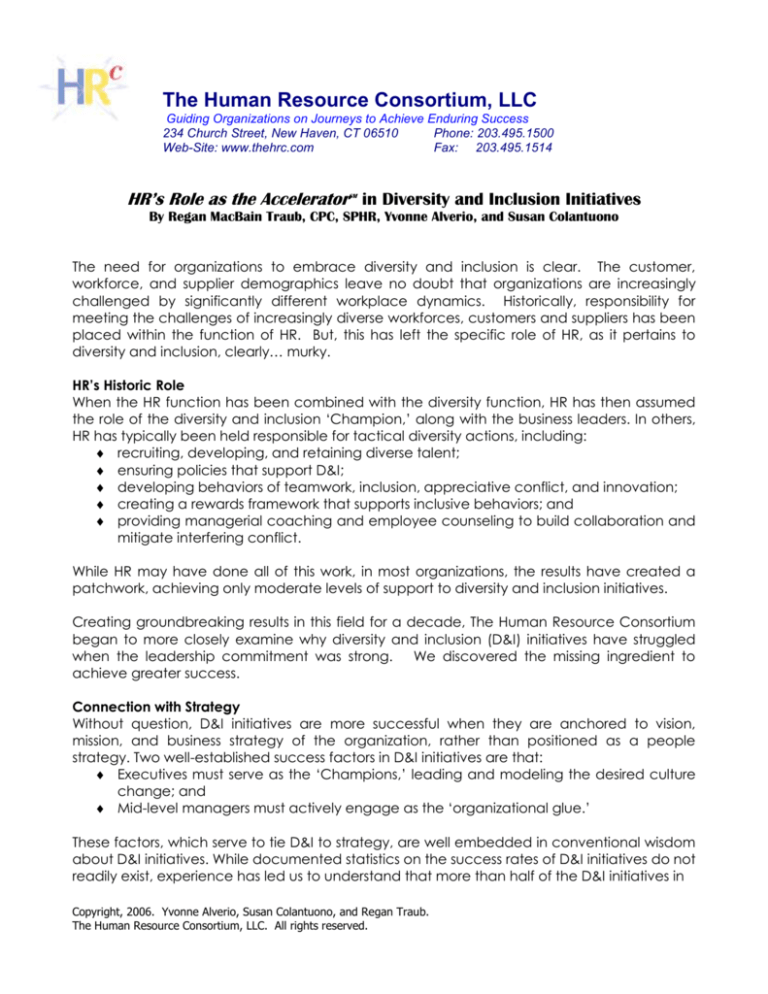
The Human Resource Consortium, LLC
Guiding Organizations on Journeys to Achieve Enduring Success
234 Church Street, New Haven, CT 06510
Phone: 203.495.1500
Web-Site: www.thehrc.com
Fax: 203.495.1514
HR’s Role as the Accelerator in Diversity and Inclusion Initiatives
SM
By Regan MacBain Traub, CPC, SPHR, Yvonne Alverio, and Susan Colantuono
The need for organizations to embrace diversity and inclusion is clear. The customer,
workforce, and supplier demographics leave no doubt that organizations are increasingly
challenged by significantly different workplace dynamics. Historically, responsibility for
meeting the challenges of increasingly diverse workforces, customers and suppliers has been
placed within the function of HR. But, this has left the specific role of HR, as it pertains to
diversity and inclusion, clearly… murky.
HR’s Historic Role
When the HR function has been combined with the diversity function, HR has then assumed
the role of the diversity and inclusion ‘Champion,’ along with the business leaders. In others,
HR has typically been held responsible for tactical diversity actions, including:
recruiting, developing, and retaining diverse talent;
ensuring policies that support D&I;
developing behaviors of teamwork, inclusion, appreciative conflict, and innovation;
creating a rewards framework that supports inclusive behaviors; and
providing managerial coaching and employee counseling to build collaboration and
mitigate interfering conflict.
While HR may have done all of this work, in most organizations, the results have created a
patchwork, achieving only moderate levels of support to diversity and inclusion initiatives.
Creating groundbreaking results in this field for a decade, The Human Resource Consortium
began to more closely examine why diversity and inclusion (D&I) initiatives have struggled
when the leadership commitment was strong. We discovered the missing ingredient to
achieve greater success.
Connection with Strategy
Without question, D&I initiatives are more successful when they are anchored to vision,
mission, and business strategy of the organization, rather than positioned as a people
strategy. Two well-established success factors in D&I initiatives are that:
Executives must serve as the ‘Champions,’ leading and modeling the desired culture
change; and
Mid-level managers must actively engage as the ‘organizational glue.’
These factors, which serve to tie D&I to strategy, are well embedded in conventional wisdom
about D&I initiatives. While documented statistics on the success rates of D&I initiatives do not
readily exist, experience has led us to understand that more than half of the D&I initiatives in
Copyright, 2006. Yvonne Alverio, Susan Colantuono, and Regan Traub.
The Human Resource Consortium, LLC. All rights reserved.
U.S. workplaces struggle to survive or outright fail. To remedy this problem, The HRC
continually refines its approach, seeking new methodology that will provide greater support
to this complex and costly initiative.
HR as Accelerator
In our quest for new solutions a striking reality arose. The role of HR has been unclear and
incomplete. Though D&I is now more typically housed within the HR function, we found
unsatisfying answers to crucial questions. What is HR’s critical success factor and role? What
value does HR create in this long-term, and complex strategic initiative? And, where is HR
likely to limit D&I success? The answer is that HR’s specialized role in D&I is that of “The
Accelerator”.
Diagnosing Current State
To define the role of HR as “The Accelerator,” we begin with The Path to an Inclusive
Organization – a model (adapted from the work of Bailey Jackson, Rita Hardiman, and Mark
Chesler). This model describes the various stages of a D&I continuum, going from an
exclusive to an inclusive state. It functions as a foundational tool for people and
organizations to diagnose where they are on the D&I continuum and what they need to do
to advance to the next level.
Identifying where the organization is in time on a D&I culture shift, prescribes the specific
information, approaches, and infrastructure support needed to allow the organization to
advance to the next level. Using this model, The HRC has clearly defined HR’s domains of
responsibility for moving itself and its organization along the path.
Based on The Path to a Culture of Inclusion, we utilize a set of comprehensive tools that:
identify which HR infrastructure, behaviors, and metrics need to be in place at each
level to advance an organization along the Path to Inclusion (like The Path, our tool
serves as both a diagnostic and prescriptive);
assess the level at which HR is currently practicing and where and how HR needs to
focus its energy to maximize its support to D&I; and
prescribe the type of consultative support the organization needs to accelerate D&I
evolution.
To grasp this concept, we pose a simplistic example. If an organization’s HR function assesses
that:
1. Diverse candidate slates are currently required for only key jobs. The HRC’s diagnostic
tool would then indicate that the recruitment function of HR is most likely at the Critical
Mass stage. To advance to the Accepting level, a diversity of candidates will need to
be required for most/all jobs.
2. Diversity awareness training has just begun, positioning the development aspect of HR
at a Symbolic Difference level (a lower level than that of Critical Mass). To reach the
Critical Mass level, HR must effectively implement D&I skill development to build the
competence of the organization to retain the newly recruited, diverse hires.
Given this assessment, HR’s strategy to ‘accelerate’ the progress of D&I should be to focus on
building internal D&I skills and capability within the organization before investing added effort
to ensure that diverse slates of candidates are required for most/all jobs. Should the
Copyright, 2006. Yvonne Alverio, Susan Colantuono, and Regan Traub.
The Human Resource Consortium, LLC. All rights reserved.
2
organization reverse the strategy or progress both equally at the same time, the organization
will likely experience extensive turnover with their new diversity of hires, generating:
poor employee relations among a diversity of employees;
increasingly negative employment brand within the diverse employment markets,
which can quickly stunt organizational growth in our current Wars for Talent, and
require a decade to recover; and
unrecoverable cost and lost performance with the turnover.
With HR’s role as a D&I Accelerator, is the need to provide the right consulting process at the
right time with the right work. In Flawless Consulting, Peter Block defines three different types
of consulting roles – expert, pair of hands, and collaborative. Utilizing Block’s consulting
model foundationally, we have built an integrated model for developing internal D&I
consulting competence that includes defining the role, building the strategy, implementing
phases of consulting practice, and conducting dialogues within D&I initiatives. This honed
competence will not only further HR’s results and credibility in D&I, it will enhance the
business’ broader perception, as well as the impact, of HR.
This new role for HR - as a valuable and accelerating force in creating a diverse and inclusive
workplace has substantial potential. Where HR has been guided to clearly and holistically
connect the HR infrastructure with D&I culture shifts, the organizational learning, behaviors
and strategy have advanced – more significantly. We see this work as yet another
opportunity for HR to irrevocably prove its value to the business.
Copyright, 2006. Yvonne Alverio, Susan Colantuono, and Regan Traub.
The Human Resource Consortium, LLC. All rights reserved.
3



